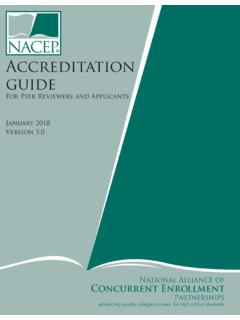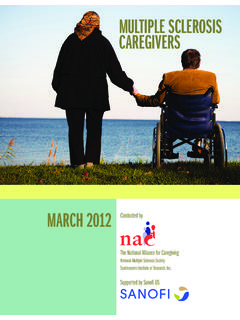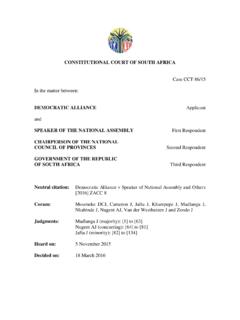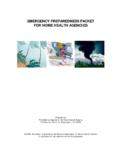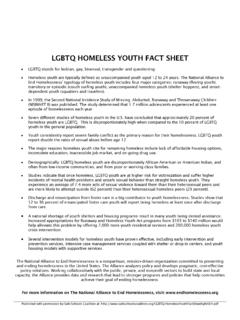Transcription of National Standards Quality Indicators - NASET
1 National Standards & Quality Indicators for secondary education and transitionThe National alliance for Secondary Education and Transition s objective in publishing this document is to provide a common and shared framework to help school systems and communities identify what youth need in order to achieve successful participation in postsecondary education and training, civic engagement, meaningful employment, and adult life. We see this framework as serving two important purposes: To respond to increased requests from states, school districts, and service providers for information on:- Research-based practices, programs, and services; and- Benchmarks for effective secondary education and transition practices. To address new responsibilities for states to focus on accountability for each and every young document combines the findings of current research on effective schooling, career preparatory experiences, youth development and youth leadership, family involvement, and connecting activities with the expertise of numerous individuals who work in these fields.
2 The National alliance for Secondary Education and Transition sees this as an evolving document, requiring continual refinement as we learn more about what all youth need to achieve positive school and postschool State governments and local school districts have been challenged to improve student achievement, graduation rates, and the successful transition of students to postsecondary education, employment, and other aspects of community living. The federal government has assumed a key role in stimulating state and local efforts to improve secondary education and transition services through a variety of policy, interagency, systems change, demonstration, and research efforts. Importantly, these efforts have focused on creating educational, workforce, community-centered, and other developmental opportunities for all youth, including youth with disabilities, English language learners, youth from diverse multicultural backgrounds, youth from low-income families, and other at-risk youth.
3 One major challenge in addressing youths diverse needs is the development of a common vision, shared goals, and coordinated strategies among schools, community service agencies, families, employers, and others. The development of a set of National Standards for secondary education and transition that embraces the perspectives of these and other stakeholders is therefore critically important in helping all youth achieve positive school and postschool November 2003, 30 National organizations assembled in Washington, DC to establish a National voluntary coalition, the National alliance for Secondary Education and Transition ( NASET ). Subsequently, additional organizations joined the NASET effort, bringing the total involved to more than 40 National organizations and individuals representing general education, special education, career and technical education, youth development, postsecondary education, workforce development, and families.
4 NASET was formed specifically to: identify what youth need in order to achieve successful participation in postsecondary education and training, civic engagement, meaningful employment, and adult life; and prioritize and address significant issues of National scale that have an impact on the development of appropriate policies and the provision of effective secondary education and transition services for all youth. National alliance for Secondary Education and Transition2 Since November 2003, NASET has worked to define a multi-organizational perspective by identifying benchmarks that reflect Quality secondary education and transition services for all youth. NASET s primary task, therefore, has been to promote high Quality and effective secondary education and transition services by articulating Standards that serve to guide policy development and professional practice at both state and local National Center on Secondary Education and Transition (NCSET), headquartered at the University of Minnesota, has facilitated the work of NASET since its inception.
5 NCSET is a National technical assistance and information dissemination center funded by the Department of Education s Office of Special Education Programs. NCSET is specifically focused on strengthening state and local capacity to improve secondary education and transition policies and practices for youth with disabilities and their families ( ).The Need for National StandardsThe establishment of a common vision, along with goals and strategies for improving results for all youth, is necessitated by several significant trends and developments nationally. These include: Policy Focus on Serving All Youth The No Child Left Behind Act (NCLB), signed by President George W. Bush in 2002, requires schools and school districts to demonstrate that all students are making adequate yearly progress, as benchmarked by test scores and other measures. NCLB specifically requires that youth with disabilities, English language learners, youth from diverse multicultural backgrounds, youth from low-income families, and other at-risk youth be fully included within state and local district testing and accountability practices.
6 Further, with the reauthorization of the Individuals with Disabilities Education Act (IDEA) in 2004, Congress renewed its commitment to supporting youth with disabilities in making a successful transition from school to adult life. Central to accomplishing this broad policy objective is the recognition that the magnitude of improvements currently needed can only be achieved through collaborative partnerships that include students and families, schools, and multiple agencies at the community, state, and National levels. Recognition that Collaboration is Needed The diverse and complex needs of many youth cannot be met by any one school district, school, community service agency, or family, regardless of their hard work or good intentions. No single entity can go it alone. Today, the focused and committed efforts of a wide range of agencies are essential to establishing and maintaining the Quality programs and practices needed to help youth to achieve positive school and postschool results.
7 Interagency collaboratives and partnerships at the community level across the are expressing the need to create a shared mission and a common set of actions and strategies to support all youth and families within communities. Formal service coordination among collaborating entities is growing and is now understood to be crucial to the transition success of many youth with disabilities and other youth with special needs. Ensuring All Youth Have the Skills Needed for Further Education and Employment Currently, the White House, Congress, the National Governors Association, and National organizations representing education and employer interests have concluded that America s high schools should be doing more to meet the needs of our youth and their families and to prepare youth for postsecondary education and employment. This view has lead to federal legislation and several emerging reform initiatives specifically focused on improving high school and postschool results for all students, including students with disabilities.
8 Ensuring All Youth Full Access to Essential Learning Opportunities Years of focused research has demonstrated that youth achieve better postschool outcomes when the transition from high school to careers, postsecondary education, and independent living is grounded in varied learning experiences which include academic development, career and technical education, work-based opportunities, service learning, youth development activities, and other related experiences. Creating this breadth and depth of learning opportunities requires National Standards & Quality Indicators3collaboration among schools, community-based youth development organizations, postsecondary programs, employers, families, and others. Families Expectations for Participation Although the nature of the relationship between parent and child changes during adolescence, families continue to play important roles in the lives of youth during high school and beyond.
9 Parents and families want to support their youth by participating meaningfully in their educational planning, life planning, and other decision-making, and have become primary stakeholders in school governance, planning committees, and other efforts. It is essential to reflect families perspectives and interests in National Standards for secondary education and Standards Development As a first step, the NASET members identified five key areas for Standards development (see figure below): 1. Schooling2. Career Preparatory Experiences3. Youth Development and Youth Leadership4. Family Involvement5. Connecting Activities Next, internal focus groups were established to address each of the five areas. Each focus group consisted of 7 10 members and included both National organization representatives and experts from the field. Group members also represented the perspectives of youth with and without disabilities, family members, educators, administrators, researchers, service providers, and employers.
10 NASET members participated in several day-long facilitated discussions to collectively describe the five areas and define associated Standards and Indicators of effective practice. The Standards and Indicators were derived from research as well as from members experiences with and knowledge about best practices in secondary education, transition, youth development, family involvement, workforce preparation, and service coordination. Criteria were established to guide the develop-ment of the Standards and Quality Indicators . It was determined that Standards and Indicators should: reflect all youth; be general enough to serve various audiences; reflect both research-based practices and recognized best practices in the field; identify what is needed for youth to participate successfully in postsecondary education and training, civic engagement, meaningful employment, and adult life; and include effective practices within secondary education and transition programs and services for youth with disabilities and other youth with special consensus-building process was used to achieve agreement on the Standards and Indicators for each of the five areas.
